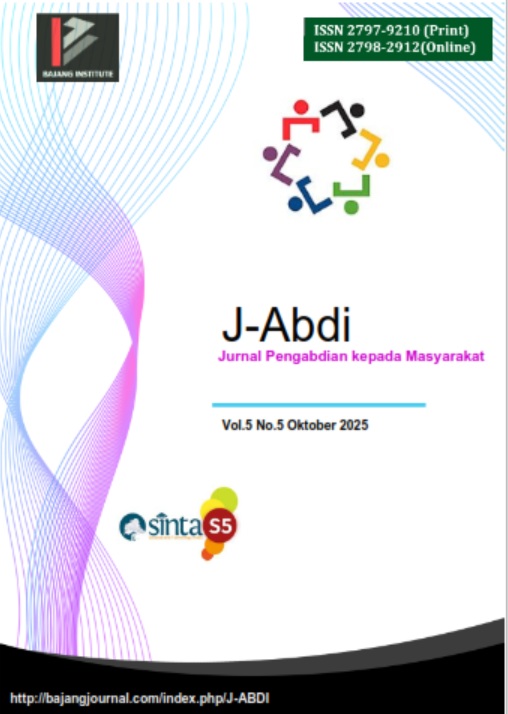DESA SEHAT DALAM PENCEGAHAN HIV/AIDS PADA REMAJA PESISIR BERBASIS VIRTUAL REALITY
DOI:
https://doi.org/10.53625/jabdi.v5i5.11361Keywords:
HIV/AIDS, Adolescents, Virtual RealityAbstract
This community service activity aimed to improve the knowledge and awareness of adolescent groups in Tupabbiring Village, Bontoa District, Maros Regency regarding the prevention of HIV/AIDS using Virtual Reality-based learning. Conducted by lecturers and students of STIKES Graha Edukasi Makassar, the activity involved preparation, implementation of health education, and evaluation stages. The health education was delivered through theory and practical sessions on HIV/AIDS prevention using Virtual Reality media. Evaluation through pre-test and post-test using SPSS showed an increase in participants’ knowledge from 51.36% to 93.03%. This activity demonstrates the effectiveness of Virtual Reality-based education in improving health knowledge and awareness among coastal adolescents with limited access to health services.
References
Hidayati, A. N. (2020). Manajemen HIV/AIDS: terkini, komprehensif, dan multidisiplin. Airlangga University Press
UNAIDS. (2021). Global HIV Statistics. In Fact Sheet 2021 (Issue June)
World Health Organization. (2022a). HIV. World Health Organization.
World Health Organization. (2022b). Summary of the global HIV epidemic, 2021. World Health Organization
United Nations Programme on HIV/AIDS. (2022). UNAIDS Global AIDS Update 2022
Kemenkes RI. (2021). Infodatin HIV AIDS. Kemenkes, 18.https://pusdatin.kemkes.go.id/resources/download/pusdatin/infodatin/infodatin-2020-HIV.pdf. In Kementerian Kesehatan Republik Indonesia
Vreeman, R. C., Scanlon, M. L., McHenry, M. S., & Nyandiko, W. M. (2015). The physical and psychological effects of HIV infection and its treatment on perinatally HIV-infected children. Journal of the International AIDS Society, 18(Suppl 6), 1–15. https://doi.org/10.7448/IAS.18.7.20258
Haacker, M. (2004). The impact of HIV/AIDS on government finance and public services. The Macroeconomics of HIV/AIDS, 2002, 198–258
Pardita, D. P. Y., & Sudibia, I. K. (2014). Analisis Dampak Sosial, Ekonomi, Dan Psikologis Penderita HIV AIDS Di Kota Denpasar. Buletin Studi Ekonomi, 19(2), 193–199
Dinas Kesehatan Sulawesi Selatan. (2021). Profil Kesehatan Sulawesi Selatan
Pringle, J., Mills, K. L., McAteer, J., Jepson, R., Hogg, E., Anand, N., & Blakemore, S. J. (2017). The physiology of adolescent sexual behaviour: A systematic review. Cogent Social Sciences, 3(1), 1–14. https://doi.org/10.1080/23311886.2017.1368858
Azadin, M. F. (2023). Teknologi Virtual Reality dalam Dunia Kesehatan. Kemenkes RI
Bardah, D., & Handiyani, H. (2020). EFEKTIVITAS PENGGUNAAN VIRTUAL SIMULASI DALAM PENDIDIKAN KEPERAWATAN: LITERATURE REVIEW Dadan. Syntax Idea, 2(2), 13–18
Saiful Arif, L., Gunawan, H., Herlambang, P. M., Internship RSUD Ciamis, D., Spesialis Syaraf, D., Waled, R., Umum, D., & Sinergi Sehat Indonesia, P. (2019). Peluang Penerapan Teknologi Virtual Reality pada Bidang Neurologi. Seminar Nasional Informatika Medis, 2019. https://journal.uii.ac.id/snimed/article/view/13852/pdf















